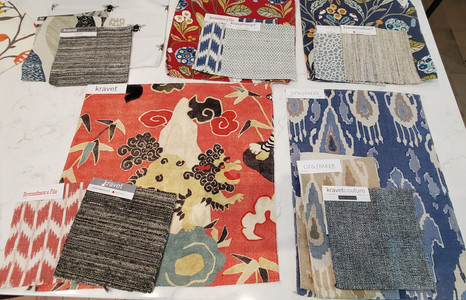How to Mix Patterns
- Julie Fergus, ASID

- Jan 9, 2024
- 2 min read
Updated: Mar 18, 2024
There is an art to successfully mixing patterns. In this example I'll walk you through the process.

For this window seat I want to combine a floral, a geometric and or stripe, and a textured multi-color. After presenting many combinations and options to my client, these fabrics above were chosen.
As I do with all projects, I present options to clients so that they can respond and decide what appeals to them. The overall color scheme for the decor is gray, red, and blue. Whichever combination my client choses, it will work with the color scheme of the home; each of these options will have a different punch of color for the space.
Once my client looked over the combinations, we went through the elimination process and narrowed down options that were most appealing to them. Then my client spent a week with the combinations looking them over in different times of the day and night and made the final choice.
From there, I chose a couple more fabrics to add to the mix for the window seat and one more for a nearby sofa.

Let's break it down.
Fabric #1 has the most punch and pattern. It is the largest pattern and pillow in the mix.
Fabric #3 utilized just the blue and the cream in a medium size "stripe" in the flame stich pattern.
Fabric #4 is a tight stripe with shades of the blue and cream.
Fabric #5 & 6 is a textured multi-color with reds cream and warm greys that are in the large-scale floral of #1 .
Fabric #7 is a blue and cream small-scale polka dot that will be on a nearby sofa and will tie in the blue and cream of the window seat.
Why it works: The variety of pattern sizes is the key element. Different sizes and shapes need to be chosen. If all of these fabrics were in the same pattern scale it would not be as interesting. Utilizing one or two colors in complementary fabrics allows one fabric to be the focal point and "star" while the other fabrics are in a supporting role.

Take a look at the combinations in the gallery and see that I applied the same principals there. It is fun to mix patterns. It can be done with multiple colors or as a tone on tone. The key is to add a variety of patterns of different sizes.
You can see more examples of pattern matching here.
Thanks for reading!










Comments